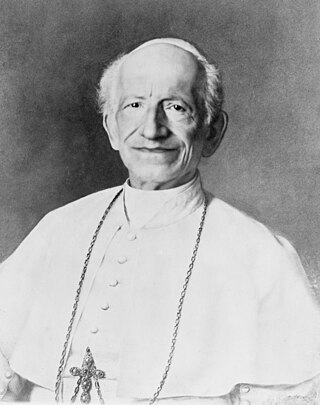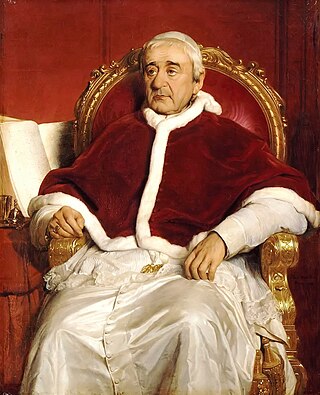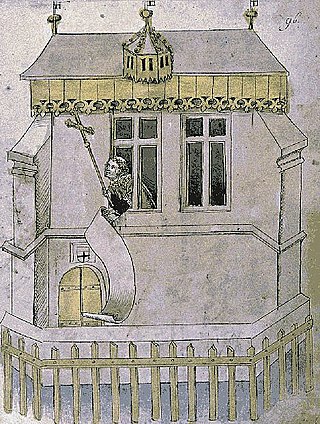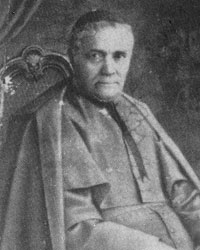
Pope Gregory XII, born Angelo Corraro, Corario, or Correr, was head of the Catholic Church from 30 November 1406 to 4 July 1415. Reigning during the Western Schism, he was opposed by the Avignon claimant Benedict XIII and the Pisan claimants Alexander V and John XXIII. Gregory XII wanted to unify the Church and voluntarily resigned in 1415 to end the schism.

Pope Leo XIII was head of the Catholic Church from 20 February 1878 until his death in July 1903. Living until the age of 93, he was the oldest pope holding office, and had the fourth-longest reign of any pope, behind those of St. Peter, Pius IX and John Paul II.

Pope Gregory XVI was head of the Catholic Church and ruler of the Papal States from 2 February 1831 to his death in June 1846. He had adopted the name Mauro upon entering the religious order of the Camaldolese.

Pope Benedict XV, born Giacomo Paolo Giovanni Battista della Chiesa, was head of the Catholic Church from 1914 until his death in January 1922. His pontificate was largely overshadowed by World War I and its political, social, and humanitarian consequences in Europe.
Papabile is an unofficial Italian term first coined by Vaticanologists and now used internationally in many languages to describe a Catholic man, in practice always a cardinal, who is thought a likely or possible candidate to be elected pope. In some cases the cardinals will choose a papabile candidate. Among the papabili cardinals who have been elected pope are Eugenio Pacelli, Giovanni Battista Montini, and Joseph Ratzinger and Jorge Mario Bergoglio (Francis). However, at times the College of Cardinals elects a man who was not considered papabile by most Vatican watchers. In recent years those who were elected pope though not considered papabile include John XXIII, John Paul I, John Paul II. There is a saying among Vaticanologists: "He who enters the conclave as pope, leaves it as a cardinal." This is a popular proverb in Italy as well, indicating one should never be too sure of oneself.

The Camerlengo of the Holy Roman Church is an office of the papal household that administers the property and revenues of the Holy See. Formerly, his responsibilities included the fiscal administration of the Patrimony of Saint Peter. As regulated in the apostolic constitution Pastor bonus of 1988, the Camerlengo is always a cardinal, though this was not the case prior to the 15th century. His heraldic arms are ornamented with two keys – one gold, one silver – in saltire, surmounted by an ombrellino, a canopy or umbrella of alternating red and yellow stripes. These also form part of the coat of arms of the Holy See during a papal interregnum. The Camerlengo has been Kevin Farrell since his appointment by Pope Francis on 14 February 2019. The Vice Camerlengo has been Archbishop Ilson de Jesus Montanari since 1 May 2020.

A papal conclave is a gathering of the College of Cardinals convened to elect a bishop of Rome, also known as the pope. Catholics consider the pope to be the apostolic successor of Saint Peter and the earthly head of the Catholic Church.
In pectore is a term used in the Catholic Church for an action, decision, or document which is meant to be kept secret. It is most often used when there is a papal appointment to the College of Cardinals without a public announcement of the name of that cardinal. The pope reserves that name to himself. The Italian language version of the phrase – in petto – is sometimes used. When the name of a new cardinal is announced or made public, it is sometimes said to be published.

Vincenzo Vannutelli was an Italian prelate of the Roman Catholic Church. He spent his career in the foreign service of the Holy See and was made a cardinal in 1890.

Habemus papam or Papam habemus is the announcement traditionally given by the protodeacon of the College of Cardinals or by the senior cardinal deacon participating in the papal conclave, in Latin, upon the election of a new pope of the Roman Catholic Church.
A papal brief or breve is a formal document emanating from the Pope.

Federico Tedeschini was an Italian cardinal of the Holy Roman Church who served as papal datary in the Roman Curia from 1938 until his death, and was elevated to the cardinalate in 1933 in pectore by Pope Pius XI.

A cardinal-nephew was a cardinal elevated by a pope who was that cardinal's relative. The practice of creating cardinal-nephews originated in the Middle Ages, and reached its apex during the 16th and 17th centuries. The last cardinal-nephew was named in 1689 and the practice was abolished in 1692. The word nepotism originally referred specifically to this practice, when it appeared in the English language about 1669. From the middle of the Avignon Papacy (1309–1377) until Pope Innocent XII's anti-nepotism bull, Romanum decet pontificem (1692), a pope without a cardinal-nephew was the exception to the rule. Every Renaissance pope who created cardinals appointed a relative to the College of Cardinals, and the nephew was the most common choice, although one of Alexander VI's creations was his own son.

The Mariology of the popes is the theological study of the influence that the popes have had on the development, formulation and transformation of the Roman Catholic Church's doctrines and devotions relating to the Blessed Virgin Mary.

Pontifical Roman Athenaeum S. Apollinare is a former pontifical university in Rome, named after St. Apollinaris of Ravenna. Its facilities are now occupied by the Pontifical University of the Holy Cross.
The Latin Letters Office is a department of the Roman Curia's Secretariat of State of the Holy See in Vatican City. It is well known among modern-day Latinists as the place where documents of the Catholic Church are written in or translated into Latin.

Antonio Maria Panebianco was an Italian prelate of the Catholic Church. He became cardinal in 1861 and held several senior positions in the Roman Curia.
This is a list of the lists of encyclicals which have been promulgated by Popes of the Catholic Church.













